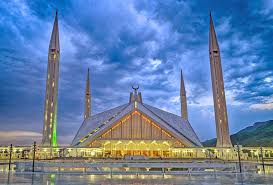Faisal Masjid_Islamabad, Pakistan
The Faisal Mosque is Pakistan's largest mosque, located in the nation's capital Islamabad. Completed in 1986, it is designed in the style of Turkish architect Vedat Dalokay, erected as a desert Bedouin tent, a symbol of Islamabad in the center of the arena.
Located north of Faisal Avenue, it is located just north of the capital city and below the Margalla Hills, in the western part of the Himalayas. It is located in the fastest part of the world against the beautiful background of Margalla Hills. This jealous place represents the incredible value of the mosque and allows it to be seen for miles to day and night.
The Faisal Mosque was transformed into the National Mosque of Pakistan and was named after the late Saudi Arabian king, Faisal bin Abdul-Aziz, who sponsored and sponsored the project.
Faisal Mosque was the largest mosque in the world from 1986 to 1993, when it was overtaken by the recently completed Hassan II Mosque in Casablanca, Morocco. Subsequent expansion of the Masjid al-Haram (Grand Mosque) of Mecca and the Al-Masjid al-Nabawi (Prophet's Mosque) in Medina, Saudi Arabia, during all the Nineties reduced the Faisal Mosque to a fourth in length.
The momentum of the mosque commenced in 1966 whilst King Faisal bin Abdul-Aziz supported the Pakistani Government's pass to construct a country wide mosque in Islamabad sooner or later at some point of a prestigious go to to Pakistan.
In 1969, international protests were staged when architects from 17 countries submitted forty-three proposals. The existing design changed to Turkish architect Vedat Dalokay. (about one hundred and twenty million USD these days). King Faisal bin Abdul Aziz was instrumental in this donation, and each mosque and highway to which it was named was named after his assassination in 1975. The mosque became finished in 1986, and was used to residence the International Islamic University. Design for the unusual design and the lack of a typical dome structure, but the biggest criticism ended when the finished mosque scale, status, and placement against the Margalla Mountains became apparent.
The building of the mosque is modern and clear, lacking traditional domes and mosque arches that are very different in this regard.
The Shah Faisal Masjid, also known as the Faisal Mosque, is located at the beginning of the Margala E-7 Islamabad mountain region.
The unusual mosque building is from the long history of the South Asian Muslim architecture, combining the cutting lines and traditional look of the Arab Bedouin tent, with its large triangular prayer hall and 4 meters. However, unlike the structure of a traditional masjid, it has no dome. Minarets borrow their texture from the Turkish way of life and are small and pencil-shaped.
The Faisal Mosque is an eight-dimensional concrete shell reinforced with hollow paper Beduoin Tent and cubic Kaaba in Mecca, surrounded by four unusual minaret renovated with the help of Turkish architecture. The architect later explained his plans to plan for college college students:
“I tried to capture the spirit, the sharing and the geometry of the Kaaba in a mysterious way. Think of the quality of each of the four minaret as the supreme explosion of the top four corners of the Kaaba - hence the invisible shape of the Kaaba is tied between the minarets in the four corners at a percentage point down. Shah Faisal Mosque compared to the Kaaba.
Now, if you are part of the apex of each minaret to the bottom of the minaret in the opposite direction, the 4-sided pyramid will be sure of these problems on the lower side inside that invisible cube. That low-level pyramid is treated like a solid frame at the same time with 4 minarets and an apex of every imaginary cube of the Kaaba.
The entrance is from the east, where the prayer corridor is in front of the front porch. The International Islamic University remained under the main courtyard, but these days have been moved to a new campus. The mosque has a library, a teaching area, a museum and a cafe.The indoors of the huge, elegant tent hall is covered with the aid of white marble and is decorated with mosaic and calligraphy with the help of famous Pakistani painter Sadequain, as well as a first-rate Turkish style chandelier. The mosaic pattern adorns the west wall, and has a kalimah inscribed at the beginning of the Kufic script, duplicated with a light image pattern.
Nekka Phullai is a hill near the mosque in Margalla Hills.
Read more:
- Helpless law and order cases and curse
- Educational problems in Pakistan 2021
- Health issues in Pakistan 2021
- Child work in Pakistan
- Pakistan is the world's second most dirtied country
- Top ten Causes of over population in Pakistan
- Electricity and energy problem in Pakistan
- Beggary in Pakistan
- The Battle of Karbala
- Most attractive quotes about education
- Heart touching quotes about friend
- Expanding number of child marriages in Pakistan
- How to create and use Twitter account
- How to create PayPal account in Pakistan
- Minar-e-Pakistan occurrence young lady TikToker Ayesha Akram uncovered
- Faisal Masjid_Islamabad, Pakistan
- Mazar-e-Quaid- Karachi, Pakistan
- 3 Crucial Causes of Illiteracy in Pakistan









No comments:
Post a Comment